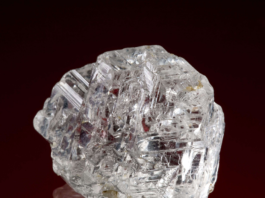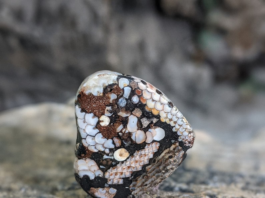Schalenblende is a unique mineral that is characterized by its distinct layered appearance, which resembles the layers of an onion or a shell. The name “Schalenblende” is of German origin and translates to “shell ore” or “layered ore,” which aptly describes its structure.

Composition: Schalenblende is primarily composed of several minerals layered together, resulting in its characteristic appearance. The main minerals typically found in Schalenblende include:
- Sphalerite (ZnS): This is the primary mineral in Schalenblende and gives it its dark, often black, color. Sphalerite is a zinc sulfide mineral and is commonly found in association with other ores.
- Wurtzite (ZnS): Another zinc sulfide mineral, wurtzite often occurs alongside sphalerite in Schalenblende. It can contribute to the dark coloration of the mineral.
- Galena (PbS): Galena is a lead sulfide mineral that is frequently present in Schalenblende. It often appears as gray or silver-gray metallic-looking layers within the mineral.
- Marcasite (FeS2): Marcasite is an iron sulfide mineral that may also be found in Schalenblende, contributing to its layered structure and metallic luster.
- Pyrite (FeS2): Pyrite, also known as “fool’s gold,” is another common mineral found in Schalenblende. It has a brassy yellow color and can occur in distinct layers within the mineral.

The specific composition of Schalenblende can vary depending on the location from which it is sourced. Additionally, other minerals may occasionally be present in minor quantities.
Schalenblende is often valued for its unique appearance and is sometimes used as a decorative stone or in jewelry making. However, due to its complex composition and variable properties, it is not as widely recognized or utilized as some other minerals.
Physical Properties

Schalenblende exhibits several physical properties that contribute to its unique appearance and characteristics. Some of the key physical properties of Schalenblende include:
- Color: Schalenblende typically displays a dark coloration, ranging from black to dark brown, often with metallic luster.
- Luster: The luster of Schalenblende is typically metallic, giving it a shiny appearance when light reflects off its surface.
- Cleavage: Schalenblende may exhibit imperfect or indistinct cleavage due to its layered structure. Cleavage refers to the way a mineral breaks along planes of weakness, and in Schalenblende, this can vary depending on the specific minerals present and their arrangement.
- Hardness: The hardness of Schalenblende varies depending on its composition, but it generally falls within the range of 3.5 to 4 on the Mohs scale of mineral hardness. This means that it is relatively soft compared to many common minerals but still harder than some materials like gypsum.
- Transparency: Schalenblende is typically opaque, meaning that light does not pass through it. However, thin sections of the mineral may exhibit some translucency.
- Streak: The streak of Schalenblende, which is the color of its powdered form, is usually dark brown to black.
- Density: Schalenblende has a density ranging from about 3.9 to 4.1 grams per cubic centimeter (g/cm³), which is relatively high compared to many common minerals.
- Crystal Habit: Schalenblende does not usually form well-defined crystals but instead occurs in layered masses or aggregates. Its structure often resembles layers or shells, giving it its characteristic appearance.
These physical properties, along with its unique composition, make Schalenblende a distinctive and visually interesting mineral.
Formation and Occurrence

Schalenblende typically forms in hydrothermal ore deposits, which are created when hot fluids circulate through cracks and fissures in the Earth’s crust, depositing minerals as they cool. The specific conditions required for Schalenblende formation involve the presence of certain elements such as zinc, lead, iron, and sulfur, as well as the right temperature and pressure conditions.
The formation of Schalenblende often occurs in association with other sulfide minerals such as sphalerite (zinc sulfide), galena (lead sulfide), pyrite (iron sulfide), and marcasite. These minerals precipitate out of the hydrothermal fluids as they cool, forming layers within the Schalenblende. The layered structure of Schalenblende is thought to result from fluctuations in the composition or temperature of the hydrothermal fluids during its formation.
Schalenblende can be found in various geological settings, including:
- Vein deposits: Schalenblende often occurs in veins within host rocks such as limestone, dolomite, or shale. These veins are formed when mineral-rich fluids migrate through fractures in the surrounding rock, depositing minerals like Schalenblende as they cool.
- Contact metamorphic zones: In some cases, Schalenblende may form in association with contact metamorphism, where rocks are altered by the heat and pressure from nearby intrusions of molten magma. The high temperatures and chemical reactions associated with contact metamorphism can create conditions conducive to the formation of Schalenblende.
- Sedimentary deposits: Schalenblende can also occur as a component of certain sedimentary rocks, particularly those formed in environments rich in sulfide minerals. In these cases, the Schalenblende may have been deposited along with other minerals in layers or beds within the sedimentary sequence.
- Hydrothermal vent systems: Some Schalenblende deposits may form near hydrothermal vent systems on the ocean floor, where hot fluids rich in minerals are expelled from beneath the Earth’s crust. These vent systems can create unique environments where minerals like Schalenblende can precipitate out of the hydrothermal fluids and accumulate on the seafloor.
Overall, Schalenblende is relatively rare compared to other minerals, but it can be found in various geological settings around the world where the right conditions for its formation exist.
Locations and Deposits

Schalenblende deposits can be found in various locations around the world, often in regions with significant geological activity and the presence of ore-forming processes. Some notable locations and deposits where Schalenblende has been found include:
- Germany: Given its German name, it’s no surprise that Schalenblende has been discovered in several locations within Germany. Notable occurrences include deposits in the Harz Mountains and the Black Forest region.
- Poland: Schalenblende has been reported in areas such as Upper Silesia and the Sowie Mountains in Poland.
- Czech Republic: Deposits of Schalenblende have been documented in regions such as the Krkonose Mountains and the Bohemian Massif.
- Austria: The Austrian Alps, particularly in regions like Styria and Carinthia, have yielded Schalenblende deposits.
- United States: Schalenblende occurrences have been reported in various states, including Illinois, Missouri, and New Mexico.
- Mexico: Some deposits of Schalenblende have been found in Mexico, particularly in regions with significant mineralization activity.
- Peru: Peru is another country where Schalenblende has been documented, often associated with other sulfide minerals in hydrothermal deposits.
- Morocco: Certain regions of Morocco have also produced Schalenblende specimens, often in association with other ore minerals.
- Australia: Schalenblende occurrences have been reported in regions such as New South Wales and Tasmania.
- Other countries: Schalenblende has also been found in smaller quantities in various other countries, including Spain, Russia, China, and Canada.
These locations represent just a sampling of where Schalenblende has been discovered. The mineral’s occurrence is often tied to specific geological conditions conducive to the formation of hydrothermal ore deposits containing sulfide minerals like sphalerite, galena, and pyrite. As a result, Schalenblende can potentially be found in other regions with similar geological characteristics.
Uses and Applications

Schalenblende is primarily valued for its aesthetic qualities rather than for any practical applications due to its relatively rare occurrence and unique appearance. Some of its uses and applications include:
- Gemstone and Jewelry: Schalenblende’s distinctive layered appearance and metallic luster make it attractive for use in jewelry and lapidary art. It is often cut and polished into cabochons, beads, or other ornamental pieces.
- Collecting and Display: Collectors of minerals and gemstones often appreciate Schalenblende specimens for their beauty and rarity. Well-formed specimens may be sought after for private collections or museum displays.
- Metaphysical and Spiritual: Like many gemstones and minerals, Schalenblende may also have symbolic or metaphysical significance for some people. It may be used in practices such as crystal healing or meditation, although these uses are not scientifically supported.
- Decorative Stone: In some cases, Schalenblende may be used as a decorative stone in architecture or interior design. Its unique appearance can add visual interest to surfaces or decorative pieces.
- Educational Purposes: Schalenblende specimens are often used in educational settings to teach students about mineralogy, geology, and the formation of ore deposits. Studying Schalenblende can provide insights into geological processes and mineral identification.
Overall, while Schalenblende may not have widespread practical applications like some other minerals, its beauty and rarity make it valued in various niche markets, including the gem and mineral collecting communities. Its unique appearance and associations with geological processes also contribute to its educational and scientific value.






